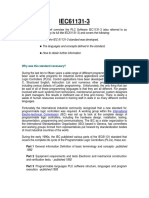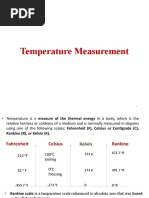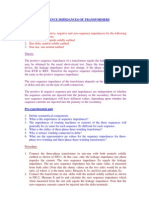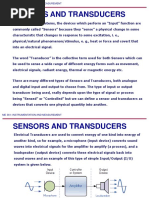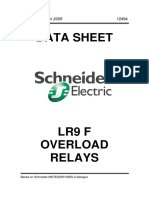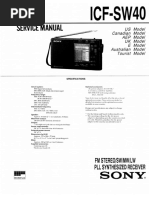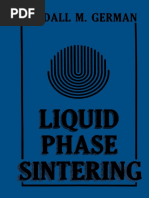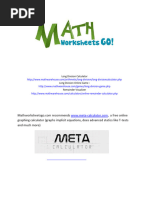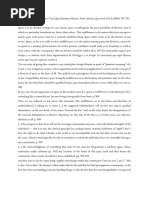PID Control
PID Control
Uploaded by
anurag_pai_1Copyright:
Available Formats
PID Control
PID Control
Uploaded by
anurag_pai_1Copyright
Available Formats
Share this document
Did you find this document useful?
Is this content inappropriate?
Copyright:
Available Formats
PID Control
PID Control
Uploaded by
anurag_pai_1Copyright:
Available Formats
PID Control
Application Note 83402
Woodward wishes to thank and acknowledge E. I. Du Pont De Nemours & Company, Inc. for granting permission to use information presented in Du Pont's ELIAS Instrumentation Training Program booklet in this Woodward publication. Du Pont's copyright to the above mention document is as follows: Copyright (1970) E. I. Du Pont De Nemours & Company, Inc.
[Written by Larry McLeister]
Woodward Governor Company reserves the right to update any portion of this publication at any time. Information provided by Woodward Governor Company is believed to be correct and reliable. However, no responsibility is assumed by Woodward Governor Company unless otherwise expressly undertaken.
Woodward 1992 All Rights Reserved
Application Note 83402
PID Control
Contents
CHAPTER 1. INTRODUCTION ........................................................................ 2
Process Control Loop.............................................................................................2 Automatic Control ...................................................................................................3 Control Loop ...........................................................................................................4 Control Modes ........................................................................................................4 Control Modes (Car Analogy).................................................................................5 Proportional Control................................................................................................5 Integral (Reset).......................................................................................................5 Derivative (Preact and Rate Time) .........................................................................5 Control Responses .................................................................................................6
CHAPTER 2. SINGLE-MODE CONTROL ......................................................... 7
On-Off Control ........................................................................................................7 Proportional Response...........................................................................................9 Proportional Gain (Effect of Settings).....................................................................9 Chapter 2 Summary .............................................................................................10 Chapter 2 Review Questions................................................................................10
CHAPTER 3. INTEGRAL AND DERIVATIVE CONTROL .................................... 11
Proportional + Integral (Open Loop).....................................................................11 Integral..................................................................................................................12 Proportional + Integral (Closed Loop) ..................................................................13 Integral (Effects of Settings) .................................................................................14 Derivative Response ............................................................................................15 Derivative (Minutes)..............................................................................................16 Proportional + Derivative (Closed Loop) ..............................................................17 Derivative (Effects of Settings) .............................................................................18 Proportional + Integral + Derivative (Closed Loop) ..............................................19 Chapter 3 Summary .............................................................................................19 Chapter 3 Review .................................................................................................20
CHAPTER 4. TUNING GUIDELINES .............................................................. 22
Controller Tuning Method Sample........................................................................24 Controller Field Tuning General ...........................................................................25 Controller Field Tuning Procedure .......................................................................27
Woodward
PID Control
Application Note 83402
Chapter 1. Introduction
Process Control Loop
With this block diagram of a control loop, the following can be shown: The dashes surrounding the measurement transmitter, the control station, and the controller indicate the "local" control station since all parts are within one case. The dashes surrounding the control station and controller only indicate the "remote" control station. The controller in this case may be mounted one of three ways: on the control station behind the control panel on a rack with other controllers in the field on or near the control valve. It may also be an integral part of the control station as the one used in the training setup. Both types of control stations will have some way of indicating (or recording) the process variable, some means for adjusting the desired set point, and a means for reading the controller output to the control valve. The "local" control station may or may not have a means for "manually" controlling the control valve. The "remote" will always have this facility. The "local" control station requires frequent visitation to determine quality of control. The "remote" station is centrally located, therefore reducing travel time and allowing side-by-side control quality scanning. 2 Woodward
Application Note 83402 The function of each block of the diagram is as follows: 1.
PID Control
Measurement transmittermeasures the process variable (temperature, pressure, level, flow, or analysis) and converts the measurement to units useful to the controller (psig, kPa, etc) or some electronic value such as 420 mA. The control station provides facility for setting the desired control point, reading the value of the measurement, transferring the operation from manual to automatic or automatic to manual, and allows manual loading of the control valve. The controller takes the set point value of the control station, compares its value to the measurement and reacts to the difference according to the values set on each response, proportional, reset and derivative. The output signal from the controller positions the control valve. The process changes resulting from the valve changes are felt by the measurement and the procedure continues.
2.
3.
4. 5.
Automatic Control
This chart is a simplified form of the previous chart. There are three things that take place: measurement decision action Measurement, of course, is the process variable to be controlled. The decision is the controller. The action is the control valve, sometimes called the final element. Note that the arrows flow continuously as does the function of any closed loop control system. All sections of the control system are continuously connected, even though action does not take place unless a change takes place that results in the process variable measured deviating from the set point (desired control point). Woodward 3
PID Control
Application Note 83402
To break the connection between any section of the loop would result in an open loop configuration. Of course, the process will then not respond to controller action. However, as later charts will show, open loop configuration is a unique way of observing controller actions or responses on an individual basis and without the interfering process response.
Control Loop
Measurement (Transmitter) 1. Temperature 2. Pressure 3. Level 4. Flow 5. X-Analysis Decision (Controller) 1. Set point vs. measurement 2. Controller response Action (Final Element) 1. Control valve 2. Pump 3. Rheostat Control loop components consist of those shown on the above chart. As mentioned earlier, three things take place in a closed loop control systemMeasurement, Decision, Action, whenever the system is in automatic. The measurement section is connected directly to the process and transmits the variable to be controlled to the control station, usually some distance away. The control station, which technically includes the controller, allows comparison between the desired control point (set point) and the measured control point. The amount of the deviation, the rate of the deviation and the duration of the deviation all predict controller response according to the controller's gain, derivative and reset settings. The action is simply the result of the controller output. It may be something other than a control valve.
Control Modes
On-Off Or (Deadband) Proportional or (Prop_Gn) Integral or (Int_Gn) Derivative or (S_D_R)
As mentioned earlier, modes of control refer to the various types of control available. Also it must be remembered that the type of control should match the process. For example, on-off control is quite adequate for home heating systems, but would be very unsatisfactory in most petroleum/chemical applications because of its cyclic characteristic. Proportional control eliminates the cyclic characteristics of the on-off mode. Integral and Derivative are refinements of and work in conjunction with proportional control. Special studies of each follow.
Woodward
Application Note 83402
PID Control
Control Modes (Car Analogy)
ON-OFFOne speed windshield wiper in light rain. One way to describe terms normally unfamiliar is to draw an analogy to something which is familiar. The analogy here for On-Off control is turning the windshield wiper "on" then "off". Its speed is not changed. It is simply turned "on" for one wipe, then turned off. As a matter of fact, most car manufacturers have a position on the wiper control that produces an "On-Off" characteristic.
Proportional Control
Setting hand throttle to keep constant speed on straight and level. Proportional control (using the same analogy) results in a certain speed as long as the car is not subjected to any load change such as a hill. If a hand throttle is set to any particular setting, the speed of the car will remain constant as long as the car remains straight and level. If the car goes up a hill it will slow down. Of course, going down a hill the car would gain speed. Proportional response is directly proportional to a process change.
Integral (Reset)
Cruise control maintains constant speed regardless of hills. Integral, sometimes called reset, provides additional action to the original proportional response as long as the process variable remains away from the set point. Integral is a function of the magnitude and duration of the deviation. In this analogy the reset response would keep the car speed constant regardless of the terrain. Integral compensates for process and set point load changes.
Derivative (Preact and Rate Time)
Accelerating into high speed lane with merging traffic. Derivative sometimes called "preact" or "rate", is very difficult to draw an accurate analogy to, because the action takes place only when the process changes and is directly related to the speed at which the process changes. Merging into high speed traffic of a freeway from an "on" ramp is no easy task and requires accelerated correction (temporary overcorrection) in both increasing and decreasing directions. The application of brakes to fall behind the car in the first continuous lane or passing gear to get ahead of the car in the first continuous lane is derivative action.
Woodward
PID Control
Application Note 83402
Control Responses
ON-OFF cyclic control PROPORTIONAL throttling INTEGRAL compensation (load or set point change) DERIVATIVE accelerated action PROPORTIONAL + INTEGRAL throttling with compensation PROPORTIONAL + DERIVATIVE throttling with accelerated action PROPORTIONAL + INTEGRAL + DERIVATIVE throttling with compensation and accelerated action
The above chart shows the characteristics of the different control responses. Keep in mind that integral and derivative work in conjunction with proportional response. Proportional response improves the cyclic characteristics of On-Off by providing a throttling action or some portion of the maximum available. It is proportional to the process variable change only. Integral compensates for load changes - process initiated or set point initiated by adding additional proportional action until the measured variable and the desired control point (set point) are the same. Integral action takes place only when a difference (deviation) exists between the Set Point and the process measurement. Derivative accelerates (advances) the Proportional action based on the speed of the process change only. It compensates for long transfer lags and reduces overshoot resulting from large process disturbances. Combinations of Proportional, Integral, Derivative will provide the type of process control required.
Woodward
Application Note 83402
PID Control
Chapter 2. Single-Mode Control
On-Off Control
The control point is at 50% of the scale. The "open loop adjust" manually moves the measurement back and forth across the control point. The controller is in automatic with its responses set to produce "ON-OFF" control characteristic. Whenever the measurement is moved above the control point, the controller output moves the action to zero (let's say valve closed). Whenever the measurement is moved below the control point, the controller drives the action to full output (valve open). Remember the measurement is driven in open loop; therefore, as long as the measurement is held above the control point, the controller (in full automatic) will hold the valve fully closed and conversely as long as the measurement is held below the control point, the controller will hold the valve fully opened.
Woodward
PID Control
Application Note 83402
This action is seen in final control elements that are either open or closed. Examples of these elements are: some types of control valves, solenoid valves, solenoid levers, and other devices that may be controlled by relay outputs.
This chart shows "ON-OFF" control in closed loop configuration. The controller is, of course, in automatic and its responses are set to produce "ON-OFF" control. Now however, the process measurement will be returned toward the control point as a result of the valve being driven to its extreme, but because the valve is driven to its extreme, the process measurement has inertia and will overshoot the control point. As soon as the process measurement crosses the control point the controller will drive the valve to its other extreme, thereby causing the cyclic action shown on the chart. Inertia of the process will produce overshoot in both directions. Since "ON-OFF" configuration is very simple and quite uncommon in its use in process control, it will not be discussed further. It is shown here only to define its characteristic and to show there are applications for it, such as home heating systems.
Woodward
Application Note 83402
PID Control
Proportional Response
This chart (in Closed Loop) graphically displays the characteristic of Proportional response. Beginning at the bottom of the graph, a step change is introduced and held as a load change. As a result of the step change, the measurement droops to control at a lower value since the valve movement was Proportional to the change in measurement only. This results in Offset between the original desired Set Point and the resulting droop in the Control Point. As can be seen, one method of correcting this Offset would be to manually reset the Set Point to bring the Control Point back up to the desired (control) Set Point. This results in a different valve position. Of course, additional process load changes or Set Point load changes would result in additional offset.
Proportional Gain (Effect of Settings)
This graph shows the effect of Proportional gain settings on control. Starting at the top of the graph a load change is introduced. With a small Proportional gain (meaning a large process change is required to produce full valve travel), stability is good but offset is very high. With a moderate gain setting (higher number setting) stability is still good - offset is still fairly high. Woodward 9
PID Control
Application Note 83402
With a high setting, offset is considerably smaller but the stability is poor. The 0.25 ratio effects a minimum area whereby the offset is reduced to a minimum while stability is in a decaying manner at 0.25% ratio. The 0.25% (1/4%) decay ratio will be discussed further during each subject block covered. The decay ratio used (0.25%) means that if the second cycle is 1/4 of the first cycle, then each succeeding cycle will be 1/4 of the preceding cycle until the cycle is not visible. The last section of this document will cover recognizing the 1/4 decay ratio more thoroughly. Since Proportional gain is adjusted to produce (only) the proper stability of a process, do not continue increasing its effect to correct offset conditions.
Chapter 2 Summary
Controller output change proportional to process change: Provides stability Introduces offset Proportional Control. Controller output change is Proportional to the process change. The amount of controller change is directly related to the process change and the Proportional gain setting on the controller. If there is no process change, there is no change in output from the controller (or valve change) regardless of the deviation. The amount of stability and offset is directly related to the setting of the Proportional setting. Stability is of course also affected by the stability of the process. In essence, the amount of output from the controller due to the Proportional setting is from the error. If there is no error, then there is no Proportional effect. The units for expressing amounts are: % P.B. (For Proportional Band - Reciprocal Of Gain) Gain Sensitivity (same action as Gain)
Chapter 2 Review Questions
1. 2. 3. 4. 5. 6. 7. 8. 9. 10. 11. 12. What are the characteristics of On-Off Control? When and where would On-Off Control be used? Describe Proportional Gain. What is the characteristic of Proportional? What units are used for expressing the amount of Proportional? How does Proportional act? When does Proportional act? How much? What happens when the deviation changes? What is a bad feature of Proportional? What does a high Proportional number yield? What does a low Proportional number yield?
10
Woodward
Application Note 83402
PID Control
Chapter 3. Integral and Derivative Control
Proportional + Integral (Open Loop)
Integral response is provided to eliminate the offset that resulted from straight Proportional control. This chart shows how the controller action is Proportional to the measurement change, but as we saw earlier, this results in offset. The Integral (or Reset) action is a function of both time and magnitude of the deviation. As long as an offset condition (due to load changes) exists, Integral action is taking place. The amount of Integral action is a function of four things: The magnitude of the deviation The duration of the deviation The Proportional gain setting The Integral setting In this Open Loop graph, the Integral response is shown increasing due to the offset condition existing between the temperature and the set point. The resultant action is the top curve showing the step Proportional response that ends as soon as the measurement stops changing. Then the Integral (or reset) action is added to the Proportional action in an amount equal to the Integral of the deviation. In other words, Reset action continues (in either or both directions) as long as there is a difference (deviation) between the set point and the process measurement. In this case, the deviation will never be eliminated (or even reduced) because the system is in Open Loop. Woodward 11
PID Control
Application Note 83402
Integral
(repeats per minute) Time of reset action to duplicate proportional action resulting from initial deviation Units are either: Minutes/Repeat or Repeats/Minute As mentioned earlier, there are two ways of expressing Integral action. The function may also be called Reset but the units for expressing the amount are related to Reset Time or Reset Rate. Integral as stated in the Woodward controls is repeats per minute (or Reset Rate) and is labeled as "INT_GN" on the PID controller. Therefore, a high amount of Integral gain (high number) would result in a large amount of Reset action. Conversely, a low Integral gain (low number) would result in a slower reset action. Reset Time is just the reciprocal of Reset Rate in that the time per repeats is the unit measure. This "minutes" per repeat is the same repeat discussed in "repeats per minute" of Reset Time. The repeat is of course, the duplication of the proportional response. However, in this case (Reset Time) it is the time of the repeats that the proportional action is duplicated. Some controllers do not adequately identify the Integral mode. Therefore, it is extremely important that the person attempting tuning operations first identify the Integral units before starting the tuning procedure. Otherwise he will not necessarily turn the Integral to its minimum and his tuning ability will be nil.
12
Woodward
Application Note 83402
PID Control
Proportional + Integral (Closed Loop)
This chart (in Closed Loop) is showing the effect of Integral action. The bottom curve is the load change. The next curve shows the set point and the measured variable, temperature. With the load change the temperature droops or deviates from the set point. The next highest curve is the Proportional action and follows the measured variable proportionately because the gain setting is obviously very nearly 1 (or a P.B. of 100%). The Integral curve adds to the Proportional curve resulting in a different valve position, thereby returning the process to the Set Point. In Closed Loop, however (as opposed to Open Loop), as the measurement decays toward the Set Point the Proportional action is taking place Proportionally to the measurement change, and the Integral action is decaying proportionately to the magnitude and duration of the deviation until the measurement reaches the set point at which time the Integral action is zero.
Woodward
13
PID Control
Application Note 83402
Integral (Effects of Settings)
This chart shows the effect of fast or slow Integral action. The actual setting number depends on whether the Reset is Time or Rate. Reset Time - High number = slow Reset Low number = fast Reset Action Reset Rate - High number = fast Reset Low number = slow Reset Action The graph is relatively self-explanatory in that for a given load change an offset results with Proportional response only. Since recovery time (for a given load change) is important, the Integral setting should remove the offset in minimum time without adding additional cycling. If two cycles are added, then too much Reset has been added. Of course, Proportional only must first establish the 1/4 decay ratio. If increased cycling occurs, the Integral must be turned off or the controller switched to "manual" if allowed to go too far. Ideally, the process should not continue to cycle after the set point has been reached as in the second curve from the bottom.
14
Woodward
Application Note 83402
PID Control
Derivative Response
In a process control loop the Derivative action is directly related to how fast the process changes (rate of change). If the process change is slow then the Derivative action is proportional to that rate of change. The top left graph shows the process change at two rates, #1 slow and #2 fast. The controller output just below shows proportional action follows the process change exactly, while the Derivative action advances the proportional action. The top right graph again shows the process changes, #1 slow and #2 fast. The graph just beneath shows the resultant curves advanced directly related to the rate of change of the process. The graph at the bottom center shows a process change and the controller response to this change in process. The proportional action is advanced when Derivative action is applied. The amount of this advancement in time is Derivative Time.
Woodward
15
PID Control
Application Note 83402
Derivative (Minutes)
Units: RATIO or MINUTES Time interval by which derivative action advances proportional action. Derivative action takes place at only three times: When the process starts to change When the rate of change takes place in the process When the process stops changing The net result of Derivative action is to oppose any process change and combined with Proportional action to reduce stabilization time in returning the process to the set point after an upset. Derivative will not remove offset. Woodward Derivative is split into two working domains, Input dominant and Feedback dominant. The allowed values for S_D_R range from 0 to 100, never set the S_D_R negative. The most common derivative is Feedback dominant, it is automatically selected with an S_D_R from 1 to 100. The less common S_D_R is Input dominant and is selected with S_D_R values between 0 to 1. Feedback dominant applies the derivative action to the integrator feedback term of the PID equation and is more stable than input dominant derivative. This will not take corrective action as early and it will be less noise sensitive. When tuning the derivative, the S_D_R will be established in the 1 to 100 range because it is easier to tune and more forgiving of excessive values. Most PIDs will employ feedback dominant derivative. Input dominant derivative applies the S_D_R term before the integrator term of the PID equation. When the S_D_R is less than 1, the derivative is input dominant and reacts very quickly to process upsets. This function is very adapted for PIDs that control the load parameter, such as load shaft turbine speed. Since the input dominant derivative is so sensitive, it should be reserved only for applications without high frequency noise. Except for input dominant and feedback dominant features, the reciprocal of one domain will appear identical in the other domain. As an example, consider an S_D_R of 5.0, the reciprocal being 1/5. That means that an S_D_R of 5.0 will appear the same as S_D_R of 0.200. The difference in response between these values of 5.0 and 0.2 is in the dominance feature. If in doubt about the type of derivative to use, then set up for feedback dominant, 1 < S_D_R < 100.
16
Woodward
Application Note 83402
PID Control
Proportional + Derivative (Closed Loop)
This Closed Loop graphic presentation shows how Derivative acts to oppose a change in process in either direction. The dashed line shows the Derivative action going through zero to oppose the process deviation traveling toward zero. Notice offset still exists between the desired set point and the drooped control point that resulted from the load change. The top curve is the resultant controller output, Proportional plus Derivative. If an upset (momentary) had occurred rather than a load change, there would be no offset.
Woodward
17
PID Control
Application Note 83402
Derivative (Effects of Settings)
This graphic presentation shows the effect of Derivative settings. The curves are relative since it depends on what type of control is desired in order to properly adjust Derivative time. For example, if minimum cycling is desired (as is shown here) then Derivative is added to the 1/4 decay cycle provided by Proportional until more than one cycle is removed and of course the 1/4 decay is destroyed. However, in most cases it is desirable to retain the 1/4 decay cycle, in which case Derivative is added to the point of removing only one cycle from the 1/4 decay ratio then the gain is increased until the 1/4 decay ratio is restored. In all the above curves, you will note offset exists since offset can only be eliminated by the addition of Integral (or Reset).
18
Woodward
Application Note 83402
PID Control
Proportional + Integral + Derivative (Closed Loop)
This graph shows the relationship of valve position to the interaction of the modes of control whenever a load change takes place in closed loop. As the temperature drops due to the load change, the proportional action moves the control valve proportionately to the measurement (temperature) change. The reset adds to the proportional action as a result of the magnitude and time (duration) of the deviation. And the derivative temporarily over-corrects based on the speed at which the measurement moves in any direction. The resultant curve (at the top) shows a similar over-correction (in this case), but in addition the valve will stay at the new position required to keep the measurement at the set point.
Chapter 3 Summary
INTEGRALOutput acts on error duration. Eliminates error The Integral action duplicates the Proportional response each minute and "walks" the output towards one extreme or the other. Since the Integral term is so dependant on the Proportional Gain, the Integral must be set only after the Proportional Gain has been established. DERIVATIVEOutput change proportional to rate of change of the process variable. Compensates for transfer lags Accelerates correction
Woodward
19
PID Control
Application Note 83402
In summary, Derivative provides a temporary over-correction to compensate for long transfer lags and reduce stabilization time on process upsets (momentary disturbances). Derivative acts by advancing the Proportional action. Derivative acts at the start of the process change, when the process changes its rate and when the process stops its change. Factors determining "how much" are: The Proportional setting, the Derivative setting and the rate of change of the process variable. Caution areas are: (1) If the Derivative is physically installed after the Proportional circuit, then the Derivative settings affect Set Point changes; (2) Do not use if high frequency noise is normally in the measured variable or the main lag is dead time. After Proportional is set to 1/4 decay ratio and Derivative is adjusted to remove one cycle as well as decreasing the 1/4 decay ratio, then the Proportional gain can be increased to restore the 1/4 decay ratio.
Chapter 3 Review
I. Control A. On-Off Control 1. High Sensitivity 2. Provides satisfactory control in certain applications. 3. No difficulty with load change conditions. B. Proportional Control 1. Reduced sensitivity to eliminate cycling. 2. Difficulty encountered with load change conditions; and with measurement and process lags. 3. ResponseProportional. 4. DescriptionController output change is Proportional to measurement change only. 5. CharacteristicProvides stability, eliminates hunting or cycling. 6. Units for expressing amountProportional, Gain, Sensitivity. 7. How does it act? By changing controller output proportionally to change of measurement. 8. When does it act? When process changes. 9. How much? Proportional to measurement change. 10. What happens when the measurement changes? Output changes (Proportional to measurement change only).
II.
Brief review of Integral Response. A. Definition. A response which duplicates Proportional action whenever a deviation occurs (offset between set point and process variable). B. C. Function. Removes offset due to process or set point load changes only. Units to express amount. Min./Repeat is Reset Time, Repeats/Min. is Reset Rate. Effect of Reset setting on control. Too fast Reset causes cycling. Too slow Reset results in longer offset recovery time. How does Reset response act? By duplicating Proportional action.
D.
E.
20
Woodward
Application Note 83402 F.
PID Control
When does Reset act? Any time a deviation between set point and process variable is present. What four factors determine how much Reset effect occurs? 1. Magnitude of load change. 2. Duration of load change. 3. Proportional Gain. 4. Reset Rate. When is Reset action required? Whenever a deviation or load changes are frequent.
G.
H.
III.
Brief review of Derivative Response. A. Description of Proportional + Derivative. A throttling control system with accelerated correction (temporary over-correction). B. Functions. (Reduces stabilization time on process (disturbances) momentary upsets and compensates for long transfer lags such as may be encountered in temperature.) Units. (Minutes) How does it act? Advances Proportional action. When does it act? At start of process change, when rate changes, when process change stops, any time the process changes. What three factors determine how much? 1. Proportional gain. 2. Rate setting. 3. Rate of change of variable. Caution for rate of change of the Set Point. 1. Depends on where Rate is installed in circuit before or after Proportional (Before Proportional is OK.) (After Proportional, set point changes are affected by Derivative. Also moving Derivative while controller is in Auto will move valve.) 2. Do not use if main lag is dead time. 3. Do not use if high frequency disturbance exists in the measurement. Effect of gain (Proportional) when adding Reset or Rate (Derivative) 1. Less Proportional to restore 1/4 decay ratio after adding Reset. 2. More Proportional to restore 1/4 decay ratio after adding Derivative.
C. D. E.
F.
G.
H.
Woodward
21
PID Control
Application Note 83402
Chapter 4. Tuning Guidelines
I. Controller Tuning Control loop factors versus controllability Suitability of responses Criteria for good control Controller tuning method Control Loop Factors versus Controllability The existence of a Control Loop does not always mean that the system is capable of controlling or controlling to the degree required. Severe changes in operating conditions, such as production capacity, may require changes in any one or more of the following items to restore proper control. A. Measurement System (transmitters) 1. Point to measurement should be such as to quickly detect changes in the controlled variable. 2. Measurement response should be fast. 3. The instrument range of measurement should be compatible with the (1%) degree of control desired. 4. Accuracy should be compatible with process requirements. Controllers 1. Modes should be matched to the application. Range of adjustment of modes (Proportional, Reset, Derivative). 2. Controller should be in alignment. 3. Controller must be tuned for specific conditions. 4. Little dead time/hysteresis. Final Control Elements (Valves) 1. Valve must be properly sized under normal process conditions. (Should not operate at or near full closed) 2. Valve response must be precise. (Position) 3. Valve must be of proper design. (Linear, equal %, etc.) Refers to flow characteristics versus % opening. 4. Type of shutoff required. 5. Power to close against the differential pressure. Controlling Means or Medium or Manipulated Variable 1. Must be capable of forcing control action, such as Recycle flow, Steam flow, to Reboiler etc. to force level or differential pressure or temperature changes. 2. Should be capable of being applied in direct response to final control element control signal.
B.
C.
D.
E. Process 1. 2. 3. 4.
Must be capable of control (proper design of equipment). Control Loops must be compatible with the control system. The loop should be designed with the objective of making the controller's job easy. Variable selected must be the one that provides control desired (temperature, pressure, level, flow, X).
22
Woodward
Application Note 83402 II. Selection of Controller Responses In general, "good" control should include: A. No tendency toward self-excitation. B.
PID Control
Process should remain close to or at set point during steady state operation. Process should match set point after load change quickly and with minimum overshoot. Proportional control alone is used when: 1. Stability of control is needed over "on-off" control. 2. Set Point changes and load changes are rare. Consider addition of Reset when frequent set point change and load changes occur to eliminate offset. Avoid the use of Reset when the controller is not continuously connected to final control element. (i.e. 2 controllers through a selector switch) Where overshoot on start-up is undesirable, consider addition of Derivative when minimum recovery time is desired or where system lag is long. Avoid addition of Derivative if the process has high frequency disturbances or if dead time lag is the main system lag.
C.
D.
E.
F.
III.
Criteria for Evaluating "Good" Control A. B. Stability. Minimum or no overshoot on start-up.
Woodward
23
PID Control C. D. Minimum area under the curve. Minimum time to reach the Control Point.
Application Note 83402
It may not be possible to have all at the same time! Therefore, a compromise between "A" and "C" is generally accepted. Depends on response of the process and what can be tolerated.
Controller Tuning Method Sample
Systematic trial and error.
Proportional
1. Put controller on Manualfrom this step on it is important that no upsets or load changes occur to process. Turn off Reset and Derivative (minimum effect). a. Lock normal valve loading pressure b. Set Integral for a minimum effect. In Woodward controls, using Integral Rate, set "INT_GN" to low number. If control had used RESET Time, then turn reset to a high value. If Reset is not properly identified, make a small load change, measure and record recovery time, then move Reset a small amount, measure recovery time, then make another small load change. If offset recovery is shorter with smaller number, then Reset is time. If a smaller number yields longer recovery, then Reset is rate. c. Set Derivative to minimum effect. Turn Derivative, in Woodward controls "S_D_R", to high number, SDR = 100. Install a small step change to determine speed of process. Record normal valve position and set point/Control Point relationship before proceeding in order to know where process normally belongs (by where the valve normally belongs). Set Proportional at a low position, around .01 to .10. Put controller in automatic and install upset of 1 to 10% depending on how much swing process can tolerate. All upsets or load changes should be installed around set point and should be as close to the same as possible (both amount and rate of change). Allow time for at least 90% of the change to take place and record cycle if any. Return controller to manual when changing Proportional (if this is peculiar to type of controller being tuned). Woodward controls do not need to be placed in manual for Proportional gain changes. If no cycle occurs, increase Proportional by doubling gain until first small cycle appears. If observation is in error and large cycling begins, switch to manual and return process to normal by manually positioning control valve to position recorded in step 4 above. If the application is turbine, then reduce Proportional Gain quickly, rather than a manual mode, to regain stability. After first small cycle is seen, increase Proportional in smaller increments until 1/4 decay ratio is obtained. Be sure to allow time for 90% of change to take place before changing settings.
2.
3. 4.
5. 6.
7.
8.
9.
24
Woodward
Application Note 83402
PID Control
Integral
10. After 1/4 decay ratio is obtained, add Integral to remove offset conditions only. 11. Turn Integral gain on to very slow action (.01 to .1 Repeats). Make set point disturbance change of 2 to 10% depending on how much can be tolerated by the process. If 1/4 ratio is not affected, double Reset action until first effect is seen (similar to Proportional step 8). After first effect is seen, add Reset in small increments until 1/4 ratio is affected to degree required and/or one more cycle is added to the Proportional cycle and the 1/4 ratio grows toward 1/2. 12. If other than 1/4 decay ratio is desired, then add Reset until stability is only slightly affected. 13. Determine recovery time of a load change (set point change of 2 to 10% depending on how much can be tolerated) if disturbance upsets were used to tune Reset mode. 14. Determine cycle of disturbance (upset) if load changes were used to tune Integral mode. If excessive cycling occurs, turn Integral off. If cycling does not recover in 1/4 ratio after Integral is turned off, switch to manual. 15. When one cycle has been added to 1/4 decay ratio as in step 11, leave Integral setting as is and lower Proportional slightly to restore original 1/4 decay ratio, then check for offset recovery time. If recovery time is too long, add more Integral as in step 11. Then lower Proportional to restore 1/4 decay ratio.
Derivative
16. Turn Derivative on to minimum (highest number). 17. Install a very small disturbance if excessive cycling occurs, turn Derivative off. Process will recover. If it does not, switch to manual and return valve position to normal. 18. If no cycling occurs, continue to add Derivative in small increments, by lowering S_D_R value, until one cycle is removed from 1/4 decay ratio. Make the same upset changes as for tuning Proportional only. 19. After 1/4 decay ratio is just affected, leave Derivative setting as is and increase Proportional until 1/4 decay ratio is restored. 20. Check both upset conditions and load change conditions after all above steps are completed. Further refinement is only possible through restarting procedure and more careful attention of 1/4 decay ratio or to desired stability attained from Proportional response tuning.
Controller Field Tuning General
The quality of regulation obtained from an automatic control system depends upon the adjustments that are made to the various controller modes. Best results are obtained when the adjustment (tuning) is done systematically. Prior training and experience in controller tuning are desirable for effective application of this procedure. Woodward 25
PID Control
Application Note 83402
This procedure will lead to controller settings which will provide after a load change: Process control without sustained cycling. Process recovery in a minimum time Controller settings derived for given operating conditions are valid over a narrow range of load change. The settings made for one operating set of conditions may result in excessive cycling or highly damped response at some other operating condition. This procedure should be applied under the most difficult operating conditions to assure conservative settings over the normal operating range. There are several methods of controller tuning in use. This procedure presents one which will be easiest to use, and at the same time, minimizes process upset. This method is one of systematic trial and error. The method given is based upon the 1/4-ratio decay cycle. The peak of each cycle is 1/4 of the preceding one. The objective is to produce a trace like the figure below.
It is good practice to keep the average of the set point changes near the normal set point of the process to avoid excessive departure from normal operating level. After each set point change, allow sufficient time to observe the effect of the last adjustment. It is wise to wait until approximately 90% of the change has been completed.
26
Woodward
Application Note 83402
PID Control
Controller Field Tuning Procedure
1. Have the process steady state on manual control at the normal set point. It is important that, for the duration of the controller tuning operation, no load changes take place. The occurrence of a load change may cause a misinterpretation of the recorder trace. Turn the Integral adjustment to the position of low Reset response, that is place the Reset adjustment at 0.02 repeats per minute (or 50 minutes per repeats). Adjust the Proportional Gain to fairly low setting. (The actual value of the Proportional Gain will depend upon the type of process variable being controlled.) Leave it this way until it is assured that the process has reached steady state. Turn the Integral adjustment to minimum Reset effect; this will reduce or eliminate the Integral function. Check to see that Derivative adjustment is set for minimum Derivative, or in Woodward controllers at 100. Switch to automatic control. Make a small change* in the set point and observe the response of the process to the Proportional Gain setting. If little or no cycling takes place, increase the Proportional Gain to 150% its previous value and make another small set point change. After each set point change, increase the Proportional Gain to twice its previous value until an "Optimum Proportional" response curve (see below) is obtained. If a change in Proportional produces a "Proportional Too High" curve (see below), lower the Proportional Gain to its last previous setting. The "Proportional Too Low" curve illustrated below represents the condition in which the proportional is too low.
2.
3.
*Set point changes can be made either up or down scale. The second change should return the set point to its original setting. Repeat this pattern through the tuning procedure.
Woodward
27
PID Control 4.
Application Note 83402
With the Proportional Gain at the setting previously obtained in step 3, make a change in set point and observe the recovery cycle. If there is no excessive cycling, increase the Integral to 0.04 repeats per minute (or 25 minutes per repeat). Make another set point change and observe results. After each set point change, make a change in the Reset adjustment to increase the Reset by 50% the previous Reset effect. Continue in this manner until a response curve like "Optimum Reset" (see below) is obtained. If an adjustment is made which produces a response curve like "Too Much Reset" (see below), then reduce the setting of the reset to the last previous value.
5.
With the Proportional Gain and Integral adjustments at the values previously obtained, turn the Derivative adjustment to minimum or to a setting 30. Make a small change in the set point and observe the response curve. If there is no excessive cycling, decrease the Derivative ratio. Make another small change in the set point and again observe the response. Continue making small set point changes and halving the Derivative time until a Optimum Mode curve (see below) results. If a Derivative setting produces a curve with "Too Much Derivative" (see below), reduce the Derivative time to the previous value.
28
Woodward
Application Note 83402 6.
PID Control
With the Proportional Gain, Integral, and Derivative adjustments at the values previously determined, repeat steps 3, 4, and 5 until controller adjustments show no further improvement. Normally, it will be found that with Derivative the Proportional can be increased. Retune the Integral function with both Proportional and Derivative settings at values which have just been developed. Now adjust the controller Proportional Gain with settings that produce a 50% decay. This is the worst case accepted response. The final Proportional Gain will the smaller of either half of this value or 80% of the value at the quarter decay ratio. Have the operator make a process load change to verify the adequacy of the controller settings. Pay particular attention to the Reset response. The figure below illustrates a typical curve.
7.
8.
Woodward
29
We appreciate your comments about the content of our publications. Send comments to: icinfo@woodward.com Please include the manual number from the front cover of this publication.
PO Box 1519, Fort Collins CO 80522-1519, USA 1000 East Drake Road, Fort Collins CO 80525, USA Phone +1 (970) 482-5811 Fax +1 (970) 498-3058
Email and Websitewww.woodward.com Woodward has company-owned plants, subsidiaries, and branches, as well as authorized distributors and other authorized service and sales facilities throughout the world. Complete address / phone / fax / email information for all locations is available on our website.
06/3/F
You might also like
- CBP1 PDFDocument634 pagesCBP1 PDFMohamed Abou El hassanNo ratings yet
- Ness D8xD16x Installer ManualDocument88 pagesNess D8xD16x Installer ManualMarkAshNo ratings yet
- Operating Instructions: Standard Converter - Cabinet Type UNL133Document32 pagesOperating Instructions: Standard Converter - Cabinet Type UNL133yusuf yusufNo ratings yet
- PLC - Iec 61131 PDFDocument6 pagesPLC - Iec 61131 PDFtripaldi_walterNo ratings yet
- VOS COBOL User GuideDocument195 pagesVOS COBOL User Guideanand_cse38100% (1)
- PID Tuning ClassicalDocument10 pagesPID Tuning ClassicalTolga DurudoganNo ratings yet
- Advanced PID ControlDocument15 pagesAdvanced PID ControlAldrian MacuaNo ratings yet
- Air To Fuel ControlDocument17 pagesAir To Fuel ControlMohamed DarwishNo ratings yet
- Operating Instructions Sigma S2Ba S2CaDocument64 pagesOperating Instructions Sigma S2Ba S2CaBerly Jimmy Alvarez MamaniNo ratings yet
- How Does A Thyristor Work?: G A Cathode CDocument10 pagesHow Does A Thyristor Work?: G A Cathode Csamith1No ratings yet
- Triggering Electrically Triggered Thyristors (Etts) : Reinforced InsulationDocument39 pagesTriggering Electrically Triggered Thyristors (Etts) : Reinforced Insulationom nishadNo ratings yet
- DECS 250 ManualsDocument374 pagesDECS 250 ManualsPhước Khang NguyễnNo ratings yet
- 2.4.temperature MeasurementnewDocument48 pages2.4.temperature MeasurementnewIroshiniNo ratings yet
- Schneider - Control Block LibraryDocument368 pagesSchneider - Control Block LibraryBreno MirandaNo ratings yet
- Gas - Turbine - Condition - Monitoring - and - Diagnostics PDFDocument26 pagesGas - Turbine - Condition - Monitoring - and - Diagnostics PDFRafael Garcia IllescasNo ratings yet
- ABB Testing ThyristorsDocument4 pagesABB Testing ThyristorsJuan Morales100% (1)
- Current Mode Controller Design For Single Phase Grid Connected Inverter Using Proportional Resonant Control StrategyDocument6 pagesCurrent Mode Controller Design For Single Phase Grid Connected Inverter Using Proportional Resonant Control StrategyijeteeditorNo ratings yet
- A Simple PID Controller With Adaptive Parameter in A DsPICDocument5 pagesA Simple PID Controller With Adaptive Parameter in A DsPICAlfian Apin Ma'arifNo ratings yet
- Virtual Instrumentation Interview QuestionsDocument3 pagesVirtual Instrumentation Interview Questionssunnysandeep994No ratings yet
- Sequence Impedence of A TransformerDocument3 pagesSequence Impedence of A TransformerchanaksNo ratings yet
- Excitation Systems: This Material Should Not Be Used Without The Author's ConsentDocument31 pagesExcitation Systems: This Material Should Not Be Used Without The Author's ConsentGnanaseharan Arunachalam100% (1)
- Boiler Level PID ControlDocument6 pagesBoiler Level PID ControlRio EstikaNo ratings yet
- WAGO PLC & IO SYSTEM. ACSPL 750-753.v1 PDFDocument16 pagesWAGO PLC & IO SYSTEM. ACSPL 750-753.v1 PDFPAULNo ratings yet
- 0-Gist of Industrial NetworkingDocument12 pages0-Gist of Industrial NetworkingsuritataNo ratings yet
- 2015 PID Tuning GuideDocument20 pages2015 PID Tuning GuideDaniel ScardiniNo ratings yet
- SPD Type Application Considerations Rev Date 01-31-2013Document3 pagesSPD Type Application Considerations Rev Date 01-31-2013michaelyoeNo ratings yet
- Robust Industrial Control Systems: Optimal Design Approach for Polynomial SystemsFrom EverandRobust Industrial Control Systems: Optimal Design Approach for Polynomial SystemsNo ratings yet
- Submitted by Vikrant Rana CH-6276Document30 pagesSubmitted by Vikrant Rana CH-6276vcoolkrazyNo ratings yet
- Chapter 3 ETAP User Guide 7 5 2Document75 pagesChapter 3 ETAP User Guide 7 5 2taiayambusuNo ratings yet
- Power FactorDocument5 pagesPower FactorZakariyaNo ratings yet
- Industrial Control SystemsDocument52 pagesIndustrial Control SystemsDeepak SharmaNo ratings yet
- ProximitySensorsCompared InductiveCapacitivePhotoelectricUltrasonicDocument60 pagesProximitySensorsCompared InductiveCapacitivePhotoelectricUltrasonicAriPermanaNo ratings yet
- PHILIPS Lighting Handbook Correspondence Course HP and MHLDocument52 pagesPHILIPS Lighting Handbook Correspondence Course HP and MHLsteven32419021No ratings yet
- DcsDocument60 pagesDcsRajeevAgrawalNo ratings yet
- How Heat Pumps WorkDocument4 pagesHow Heat Pumps Worksh5bootNo ratings yet
- Micronet™ TMR 5009 Digital Control Operations Manual: Woodward Governor CompanyDocument202 pagesMicronet™ TMR 5009 Digital Control Operations Manual: Woodward Governor CompanyMenno AkkermanNo ratings yet
- Effective Use of PID ControllersDocument132 pagesEffective Use of PID Controllerssybaritz100% (2)
- O2 Analyser,,YokoDocument13 pagesO2 Analyser,,YokoNogeshwar Kumar DewanganNo ratings yet
- BA BT300 DLT1201 13 aEN 009Document188 pagesBA BT300 DLT1201 13 aEN 009Teddy HariyantoNo ratings yet
- 02 PDFDocument17 pages02 PDFSerban LucianNo ratings yet
- Ansi/Ashrae/Iesna Standard 90.1-1999/2001/2004Document13 pagesAnsi/Ashrae/Iesna Standard 90.1-1999/2001/2004Win San HtweNo ratings yet
- The Guide To PID TuningDocument29 pagesThe Guide To PID TuningIvan Oxford100% (1)
- 2 Basics Sensors and TransducersDocument33 pages2 Basics Sensors and TransducersMorshedul IslamNo ratings yet
- LFL1Document13 pagesLFL1Thiago FernandesNo ratings yet
- Connecting To Allen-BradleyDocument16 pagesConnecting To Allen-Bradleycjutp86No ratings yet
- Automatic Hydro Power Plant Monitoring and Controlling Using PLC & SCADADocument6 pagesAutomatic Hydro Power Plant Monitoring and Controlling Using PLC & SCADAIJSTENo ratings yet
- Control of Heat Recovery Steam GeneratorDocument5 pagesControl of Heat Recovery Steam Generatordrmsrmurty9473100% (5)
- Pid Good Tuning A Pocket GuideDocument120 pagesPid Good Tuning A Pocket GuideHeidi HillNo ratings yet
- BUSTION MANAGEMENT - BOILER DRUM - SIEMENS - AD353-105r3 PDFDocument5 pagesBUSTION MANAGEMENT - BOILER DRUM - SIEMENS - AD353-105r3 PDFGeorge MarkasNo ratings yet
- Refrigerant SafetyDocument4 pagesRefrigerant SafetyPratikno SajaNo ratings yet
- Schneider LR9 F Overload RelaysDocument15 pagesSchneider LR9 F Overload RelayscelectricNo ratings yet
- Flujo Metro Krohne Optiflux 4300CDocument56 pagesFlujo Metro Krohne Optiflux 4300CItalo F. Araya Guerrero0% (1)
- Application Note 83402: PID ControlDocument32 pagesApplication Note 83402: PID Controlmanashbd100% (1)
- PID ControllersDocument9 pagesPID Controllerszs94qjqcx7No ratings yet
- Courseware Sample by Lab-VoltDocument24 pagesCourseware Sample by Lab-VoltiedmondNo ratings yet
- Industrial Process Control Basic ConceptsDocument39 pagesIndustrial Process Control Basic Conceptskaezzar10100% (2)
- Ingenieria de ControlesDocument91 pagesIngenieria de ControlesJulio César Millán BarcoNo ratings yet
- Lab Report CompleteDocument30 pagesLab Report Completefahadfiaz0% (1)
- Model Evaluation MetricsDocument21 pagesModel Evaluation MetricsYoussef MissaouiNo ratings yet
- Winnie Yamfwa Book Essay: Children of My Heart Course ED6821 Instructor: Dr. Evie Plaice Faculty of Education, University of New BrunswickDocument14 pagesWinnie Yamfwa Book Essay: Children of My Heart Course ED6821 Instructor: Dr. Evie Plaice Faculty of Education, University of New Brunswickapi-322057336No ratings yet
- FKAAB BFF Courses Flow 2022Document1 pageFKAAB BFF Courses Flow 2022Susmitha A/p RajamaniNo ratings yet
- W11 - Passive VoiceDocument24 pagesW11 - Passive VoiceNgô TrúcNo ratings yet
- C2L2Document2 pagesC2L2Don Zian EncarnacionNo ratings yet
- Sheet Pilewwalls Note - Example and AsignmentDocument90 pagesSheet Pilewwalls Note - Example and Asignmentdereje werkuNo ratings yet
- OTP2 e Teachers KitDocument80 pagesOTP2 e Teachers KitMarcela Gonzalez Orsini50% (2)
- Biofeedback An Evidence Based Approach in Clinical Practice: January 2009Document12 pagesBiofeedback An Evidence Based Approach in Clinical Practice: January 2009bastianusjuatmadjaNo ratings yet
- CRIMEDocument5 pagesCRIMEAli Azam Khan100% (2)
- Curriculum Vitae of Dr. G.ThimmaiahDocument23 pagesCurriculum Vitae of Dr. G.Thimmaiahkcp123No ratings yet
- Sony Icf Sw40Document26 pagesSony Icf Sw40ﹺ ﹺ ﹺ ﹺ ﹺ ﹺNo ratings yet
- Director's StatementDocument5 pagesDirector's StatementMeganPhillipsNo ratings yet
- Liquid Phase SinteringDocument242 pagesLiquid Phase SinteringAbir Roy100% (1)
- Long Division With Remainders Zeros in QuotientDocument4 pagesLong Division With Remainders Zeros in Quotienthersano.michelle.valmoriaNo ratings yet
- Population Geo Teacher CALA GuideDocument2 pagesPopulation Geo Teacher CALA Guidejames jumaNo ratings yet
- Lec 8 Storage and Retrieval System (Compatibility Mode) PDFDocument23 pagesLec 8 Storage and Retrieval System (Compatibility Mode) PDFMuhammadImranNo ratings yet
- Chapter 4eDocument4 pagesChapter 4eOK DUDENo ratings yet
- Name Sex Application No Password LRQXC7 Roll Number Date of BirthDocument2 pagesName Sex Application No Password LRQXC7 Roll Number Date of BirthJayant Kumar NathNo ratings yet
- 2013-2014 LTRC Annual ReportDocument28 pages2013-2014 LTRC Annual ReportwalaywanNo ratings yet
- Selectionsfromer 00 ErasialaDocument180 pagesSelectionsfromer 00 ErasialaJavierNo ratings yet
- Handbook of Thermoplastics Injection Mould Design - P - S - Cracknell Robert William DysonDocument152 pagesHandbook of Thermoplastics Injection Mould Design - P - S - Cracknell Robert William Dysondyw323No ratings yet
- Amimul Ahsan - Convection and Conduction Heat Transfer-Intech (2011) PDFDocument406 pagesAmimul Ahsan - Convection and Conduction Heat Transfer-Intech (2011) PDFARUN CHAND Dept. of Mechanical Engg., IIT (BHU) VaranasiNo ratings yet
- UEFI Spec 2 - 6Document2,706 pagesUEFI Spec 2 - 6Anonymous Ys0DraQxgNo ratings yet
- 14 Analogy NumbersDocument1 page14 Analogy Numberssp090608No ratings yet
- Hwre-Lec-Flood Routing PDFDocument65 pagesHwre-Lec-Flood Routing PDFabhijeetNo ratings yet
- The Go GetterDocument73 pagesThe Go GetterJuniette P. Bermudez Zarruk100% (1)
- Notes On "Space and Nomos" by Felipe Martínez MarzoaDocument2 pagesNotes On "Space and Nomos" by Felipe Martínez MarzoaDiego MartínezNo ratings yet
- The Crosby PhilosophyDocument9 pagesThe Crosby PhilosophyJulia AsiaticoNo ratings yet
- Types of JournalsDocument1 pageTypes of JournalsbishwojyotiNo ratings yet



